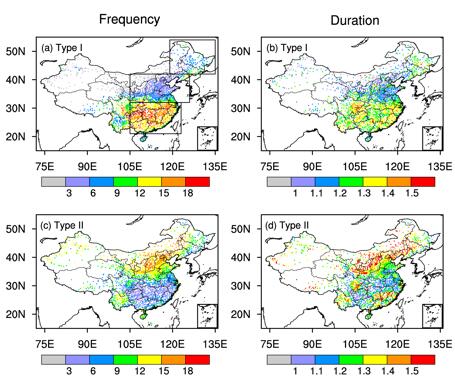How Do Two Types of Flash Drought Evolve across China?
Date:2018-10-12
Flash drought is a rapidly intensifying water deficit process accompanied by high temperatures in a short period of time. Recently, heat extremes have become more frequent in a warming climate, and substantially increased the occurrence of flash drought, which has severely threatened crop yields and water supply.
Dr. WANG Linying and Professor YUAN Xing, from the Institute of Atmospheric Physics, Chinese Academy of Sciences, used in-situ observations and reanalysis datasets to explore the long-term variability and trends of two types of flash drought. Type I flash drought is high-temperature driven, combined with increased evapotranspiration (ET) and decreased soil moisture; while type II flash drought is initialized by a lack of rainfall, and combined with decreased ET and warmer temperatures. They found that both types of flash drought have increased significantly in the past 30 years, but with a two-fold greater increase for Type I compared with Type II.

Spatial distribution of the frequency and duration of two types of flash drought.
They further examined the spatial distribution characteristics of flash drought under two different physical mechanisms and the connection with seasonal drought, and uncovered some interesting findings, as explained by Dr. WANG:
"The anticyclonic circulation patterns can provide favorable conditions for both types of flash drought. But as the local climate, vegetation and soil moisture conditions are quite different, the spatial distributions of the two types of flash drought are different as well. In humid and semi-humid regions, where the moisture supply is sufficient, ET is mainly restricted by available energy, so high temperatures can elevate the ET quickly, which explains why Type I flash drought occurs preferentially over humid and semi-humid regions, such as southern China. Composite analysis showed that anomalously high temperatures one pentad before the onset of flash drought leads to a rapid increase in ET and reduced soil moisture. For flash drought associated with seasonal drought, there is a greater likelihood of occurrence during the onset phase of seasonal drought over southern China. In northern China, meanwhile, due to the limited terrestrial moisture supply, ET decreases with the decrease in soil moisture, resulting in Type II flash drought. Also, they are more common in both the onset and recovery phases of seasonal drought.”
Professor YUAN further explains that the perfect conditions for flash drought are during dry/wet transition periods, which may provide a basis for the early warning of flash drought by connecting multiscale drought phenomena.
Reference
Wang, L. Y., and X. Yuan, 2018: Two types of flash drought and their connections with seasonal drought. Adv. Atmos. Sci., 35(12), https://doi.org/10.1007/s00376-018-8047-0 .
Contact: Ms. LIN Zheng, jennylin@mail.iap.ac.cn
